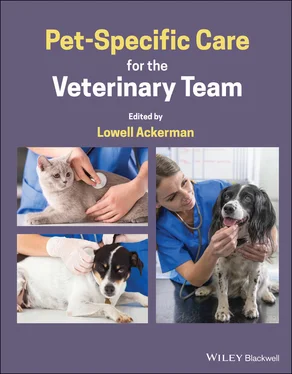Some pure breeds and purposefully bred mixed‐breeds (designer or “bred‐for‐rescue” dogs) do not have specific prebreeding health screening requirements. All parents of purposefully bred litters should have prebreeding health examinations (musculoskeletal, heart, eye, etc.) and history taken for episodic hereditary disease (allergies, seizures, chronic gastrointestinal disease, etc.) to determine their suitability for breeding (see 3.4Predicting and Eliminating Disease Traits). Prebreeding health evaluations should become as routine and commonplace as equine prepurchase examinations.
In most instances, the veterinary team is not asked for advice by a client prior to a purchase or adoption. When an appointment is being made for examination of a new purposefully bred puppy or kitten, the owner should be told to bring all paperwork provided by the breeder, pet store, broker, or agent. If evidence of health screening on the parents has not been provided, health test results that may have been performed on the parents may be looked up in online health testing databases such as the OFA.
If health screening results are not available, one can access the prebreeding health screening requirements or testable diseases and have the owner ask the breeder for health testing information on the parents. This may be the only way to educate the owner and breeder on the ethical obligation of health screening and health‐conscious breeding. Selective pressure is the only way to reduce the frequency of genetic disorders in purposefully bred dogs and cats. Health‐screened parents produce healthier kittens and puppies.
3.8.4 Genetic Counseling in Owned Animals
Veterinarians and the veterinary team should be knowledgeable about which genetic disorders have appropriate testing available, and in what patients they should be run (see 3.4Predicting and Eliminating Disease Traits). If parental documentation of genetic testing is not available, certain breeds should undergo genetic testing early in life (see 3.6Genetic Testing). For example, patients from breeds with an incidence of von Willebrand disease should be tested so that measures can be taken to prevent excessive hemorrhage during surgery or injury. Patients at risk of carrying the mdr1 mutation (mostly herding breeds) should be tested before drug treatment. Owners of large‐breed puppies can be counseled to feed lower calorie “large‐breed growth or puppy” foods to provide for a more uniform growth rate and better joint development. Boxers should be tested while young for the dominant arrhythmogenic right ventricular cardiomyopathy (ARVC) gene. Carriers can be auscultated for arrhythmias through life, and if they occur can be put on antiarrhythmic drugs to prevent heart failure.
As more research is being done, more disease liability genes are being identified. Some of these genes occur in only a small “familial” population of a breed or only in a research setting while some cause breed‐wide disease.
The focus of molecular genetic testing is now shifting to panel (multiplex) testing that includes many mutations found across all breeds. It is much less expensive to use a gene chip that runs hundreds of genetic tests for mutations, traits, and ancestry on a single sample. This is what is found with several commercial genetic testing companies for dogs and cats. With the results of such testing, genetic counseling becomes more important. Many genetic mutations that cause disease in some breeds have no health consequences in other breeds. An example is the sod1 mutation test for liability to develop degenerative myelopathy (DM). This is a significant clinical disease in eight breeds, although the sod1 mutation is found across all breeds and mixed‐breed dogs. The presence of the gene mutation is not predictive for clinical disease if the breed is not actually predisposed to the disease. Genetic testing companies should provide some genetic counseling based on the breed or mixed‐breed status of the specific patient. Decisions based on inappropriate test interpretation may be worse than having no test at all.
The expression of some genetic disorders cannot be altered. If a genetic test is available, it should be utilized prepurchase so that owners are not burdened with predictable genetic disease. However, for owned animals, it is a personal decision whether the owner wants to know if their pet is likely to develop a nontreatable genetic condition later in life. These include polycystic kidney disease (PKD) in Persian, Himalayan and related cats, lysosomal storage diseases, and the (poorly penetrant) liability gene for DM in susceptible breeds. These genetic tests can also assist with ruling out diagnoses in clinical patients with suspected genetic disease.
Dietary recommendations should be offered for identified genetic predispositions such as feline lower urinary tract disease in cats, dogs and cats with nonstruvite bladder stones or “crystals,” and obese “prediabetic” cats. Behavioral counseling and early training recommendations should be offered for breeds or individuals demonstrating aberrant or pathological behaviors.
Owners may also bring results of direct‐to‐consumer genetic tests or tests of ancestral breed background for interpretation (see 3.6Genetic Testing).
3.8.5 Breeding Recommendations
As stated above, prebreeding health evaluations should be performed on all prospective breeding cats or dogs, whether for purebred or mixed‐breed planned matings. Breed‐specific genetic screening requirements should be performed, as well as a medical history review and thorough examination for hereditary disease. Dogs and cats affected with genetic disease where no genetic tests for liability genes occur should be selected against for breeding.
As stated above, the results of individual DNA tests should be evaluated to ensure that the genetic disease exists as a clinical entity in the breed and that the genetic test has been validated in the country's breed population. Some genetic tests were developed in one country but the DNA variation is not associated with the disease in all breed populations around the world. Genetic counseling and breeding decisions based on genetic test results need to be validated in each breed population.
Based on different modes of inheritance, there are guidelines to preserve breeding lines and genetic diversity while reducing the risk of producing carrier or affected individuals.
In the case of a simple autosomal recessive disorder for which a direct genetic test for carriers is available, the recommendation is to test breeding‐quality stock, and breed clear to clear or, if necessary to preserve genetic diversity, clear to quality carrier . This prevents affected offspring from being produced. Breeders should be counseled to replace carriers in a breeding program with a quality normal‐testing offspring once it is possible to do so. This will maintain breed quality and diversity. Other offspring determined to be carriers should be placed in nonbreeding pet homes. The breed frequency of disease‐causing genes is usually less than the 50% produced from normal to carrier matings. It is desirable not to increase the frequency of carriers in the population.
If a breeder finds that a quality individual is a carrier, many are inclined to remove it from their breeding consideration. This is the wrong decision for the breeder and the breed. The individual dog or cat was already determined to have qualities acceptable for breeding. Genetic testing should be used to increase a breeder's choices, not limit them. Eliminating all carriers of testable disease‐causing genes significantly restricts breed genetic diversity. Any quality individual that would have been bred if it had tested normal should still be bred if it tests as a carrier, at least until enough quality clear individuals are available for the breeding program. A genetic test for a simple autosomal recessive disorder should not change who gets bred, only who they get bred to. As each breeder tests and replaces carriers with normal‐testing offspring, the problem for the breed as a whole diminishes.
Читать дальше












